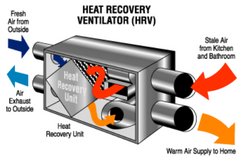What is a Heat Recovery Ventilator(HRV)?
 Heat Recovery Ventilation or HRV’s were introduced to the housing industry as new homes started being built with energy efficiency in mind. Being built very tight with no leakage, an air exchange system was needed to bring fresh air into the home. Previous building practices allowed fresh air into the homes through cracks and spaces making them more expensive to heat and cool, but allowed the new home moisture to escape much quicker. The air in older homes can change 1.5 times per hour with no need for additional equipment while in newly built homes the HRV changes the air 0.5 times per hour or one third of the time than older homes.
Heat Recovery Ventilation or HRV’s were introduced to the housing industry as new homes started being built with energy efficiency in mind. Being built very tight with no leakage, an air exchange system was needed to bring fresh air into the home. Previous building practices allowed fresh air into the homes through cracks and spaces making them more expensive to heat and cool, but allowed the new home moisture to escape much quicker. The air in older homes can change 1.5 times per hour with no need for additional equipment while in newly built homes the HRV changes the air 0.5 times per hour or one third of the time than older homes.
The HRV system exhausts stale air and replaces it with an equal amount of fresh air. The two streams of air are passed through the core of a heat exchanger, where heat from the exhausted air meets the cooler incoming air recovering 70-80% of the heat from the exhausted air. As you can see in the diagram there is no moisture added or removed by the system. The system is limited to exchanging and reheating the air. It is very energy efficient but does not have humidification or dehumidification capabilities.
Most homeowners feel the HRV system controls the humidity in the home, but this is not true. The controls are very misleading. When the dial is turned to 40%, home owners feel this is the relative humidity setting and they are creating the perfect conditions for the hardwood floor. In the heating season it is difficult to have the humidity in the home above 30% RH. Having the dial set at 40, the HRV will not come on until the humidity reaches 41% which will not provide the recommended 0.5 air changes per hour needed for a healthy home.
HRV’s should not be operated in the high humidity summer months as they just bring in the warm humid air, putting more stress on your air conditioning. Air conditioners remove moisture from the air only when they are operating. Air conditioners start and stop by temperature not humidity. Because of this the air conditioner does not replace a dehumidifier as the main source of moisture removal. If outside relative humidity is between 30-50% open your windows and enjoy the fresh air. In summer months the solution is to set a dehumidifier at 40% so it will come on only when needed.
In winter months, the colder outside air is drawn in by the HRV, and when heated the relative humidity drops substantially, far below our recommended low of 30%. Over use of the HRV in winter months allows too much dry air into the home causing hardwood flooring to shrink excessively, not to mention how unhealthy it is for humans and pets (please see chapter 2). The cure is simple; operate a humidifier that will maintain proper humidity levels.
If your home is under construction I would seriously consider upgrading your HVAC system to include a dehumidifier and a humidifier.
Heat Recovery Ventilator Information Summary
- HRVs do not add or take away moisture
- Don’t operate HRVs in the humid months
- Air conditioners only remove moisture when running
- Dehumidifiers and humidifiers are controlled methods of reducing and adding humidity
- Hardwood flooring and humans enjoy the benefits of humidity levels between 30-50%



